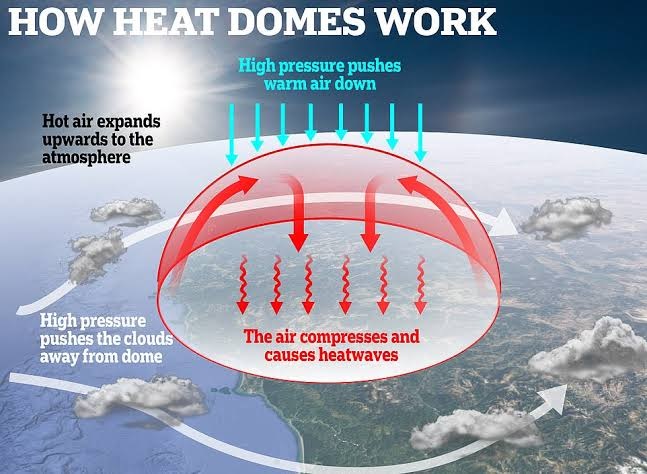Ahmedabad
(Head Office)Address : 506, 3rd EYE THREE (III), Opp. Induben Khakhrawala, Girish Cold Drink Cross Road, CG Road, Navrangpura, Ahmedabad, 380009.
Mobile : 8469231587 / 9586028957
Telephone : 079-40098991
E-mail: dics.upsc@gmail.com

News: In the past week places across the southwest and eastern parts of the United States recorded temperatures as warm as those seen in late June or early July, and the unusual warming was caused by a phenomenon known as ‘heat domes’
→ A heat dome is a type of high-pressure system that forms over a large area in the atmosphere, and causes extremely hot and dry weather conditions.
→ The system traps hot air and prevents it from flowing to rise and cool. This air then becomes compressed and heats up, leading to a dome-shaped area of hot air that can persist for several days or even weeks.
→ A number of meteorological elements work together to create a big-high pressure system in the atmosphere.
→ Climate change has also been identified among the contributing factors to the increased frequency and intensity of heat domes.
→ The intensity and duration of a heat dome can also be influenced by other factors, such as the amount of moisture in the air and the presence of other weather systems.
Locations with a lot of land and relatively dry air, such as plains and deserts, serve as a favourable condition for heat domes to form as well.
→ It can have significant impacts on human health, particularly vulnerable populations such as elderly individuals, children and those with pre-existing health conditions that can be aggravated by extreme heat.
→ People who work outdoors – Construction workers, farmers, agricultural workers are at increased risk of heat related illness.
→ Droughts and wildfires are some of the most devastating bearings due to the hot and dry conditions, paired up with reduced rainfall and increased evaporation rates.
→ Reducing greenhouse emissions – Transitioning to renewable energy sources, improving energy efficiency and promoting sustainable transportation.
→ Investing in green infrastructure – Parks, green roofs, tree planting (Especially in cities)
→ Building codes and standards can help ensure that new buildings are designed to withstand extreme heat and maintain indoor comfort during heat waves.
→ Reducing heat-trapping surfaces - Cities can take steps to reduce the amount of heat-trapping surfaces, such as asphalt and concrete, which can exacerbate the urban heat island effect.
→ Educating the public about the risks of extreme heat and how to stay safe during heat waves can help reduce the incidence of heat-related illness and mortality.

Address : 506, 3rd EYE THREE (III), Opp. Induben Khakhrawala, Girish Cold Drink Cross Road, CG Road, Navrangpura, Ahmedabad, 380009.
Mobile : 8469231587 / 9586028957
Telephone : 079-40098991
E-mail: dics.upsc@gmail.com
Address: A-306, The Landmark, Urjanagar-1, Opp. Spicy Street, Kudasan – Por Road, Kudasan, Gandhinagar – 382421
Mobile : 9723832444 / 9723932444
E-mail: dics.gnagar@gmail.com
Address: 2nd Floor, 9 Shivali Society, L&T Circle, opp. Ratri Bazar, Karelibaugh, Vadodara, 390018
Mobile : 9725692037 / 9725692054
E-mail: dics.vadodara@gmail.com
Address: 403, Raj Victoria, Opp. Pal Walkway, Near Galaxy Circle, Pal, Surat-394510
Mobile : 8401031583 / 8401031587
E-mail: dics.surat@gmail.com
Address: 303,305 K 158 Complex Above Magson, Sindhubhavan Road Ahmedabad-380059
Mobile : 9974751177 / 8469231587
E-mail: dicssbr@gmail.com
Address: 57/17, 2nd Floor, Old Rajinder Nagar Market, Bada Bazaar Marg, Delhi-60
Mobile : 9104830862 / 9104830865
E-mail: dics.newdelhi@gmail.com